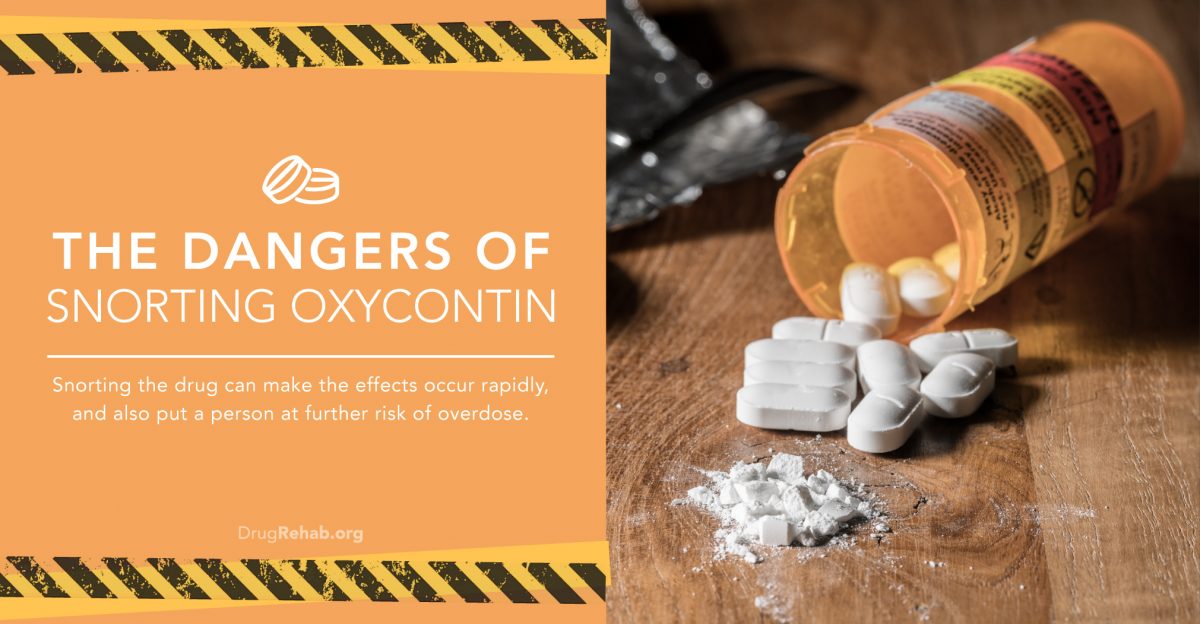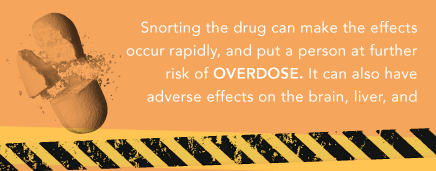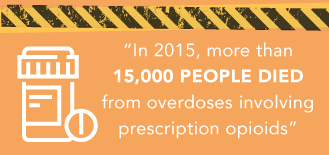
Have you ever thought “I ate so much, I couldn’t eat another bite!”? Or have you felt bad for eating the last cookie? Sometimes a person with an addiction is so stuck in the mindset of more, more, more—that the idea of stopping can seem impossible, and stealing can become just another one of the hurtful things that an opiate addiction drives them to do. Someone suffering from an addiction to Oxycontin might become a completely different person than the one you used to know.
The same person who used to share with you and laugh with you might now steal from you without batting an eyelash. Along the way a person with an opiate addiction might think of new ways to use Oxycontin like inhaling the vapors, parachuting, injecting, or snorting. Eventually their mind can be so hijacked from the opioid that they seem completely lost whether their high or not. Snorting Oxycontin can have dire consequences other than just addiction.
Definition Of Addiction
A person might become addicted to opioids even with a physician’s prescription, and drugs like Oxycontin can feel really good; at least for a little bit, then they quickly become a person’s vice. Addiction is defined by the National Institute on Drug Abuse as “a chronic, relapsing brain disease that is characterized by compulsive drug seeking and use, despite harmful consequences. It is considered a brain disease because drugs change the brain; they change its structure and how it works.” No matter which drug you’re using—crystal meth, heroin, cocaine, crack, Vicodin, PCP, alcohol, or Oxycontin; they’re all addictive.
Oxycontin—Opioid Addiction
What happens is drugs bind to the opiate receptors in a person’s brain which create dopamine. There are several different factors that will be present before a person is truly dependent on a drug. When a person is diagnosed with a substance use disorder, at least two problems, from the Diagnostic and Statistical Manual of Mental Disorders will occur:
- The substance is often taken in larger amounts or over a longer period than was intended.
- There is a persistent desire or unsuccessful effort to cut down or control use of the substance.
- A great deal of time is spent in activities necessary to obtain the substance, use the substance, or recover from its effects.
- Craving, or a strong desire or urge to use the substance.
- Recurrent use of the substance resulting in a failure to fulfill major role obligations at work, school, or home.
- Continued use of the substance despite having persistent or recurrent social or interpersonal problems caused or exacerbated by the effects of its use.
- Important social, occupational, or recreational activities are given up or reduced because of use of the substance.
- Recurrent use of the substance in situations in which it is physically hazardous.
- Use of the substance is continued despite knowledge of having a persistent or recurrent physical or psychological problem that is likely to have been caused or exacerbated by the substance.
Tolerance, as defined by either of the following:
- A need for markedly increased amounts of the substance to achieve intoxication or desired effect.
- A markedly diminished effect with continued use of the same amount of the substance.
- Withdrawal, as manifested by either of the following:
- The characteristic withdrawal syndrome for that substance (as specified in the DSM- 5 for each substance).
- The substance (or a closely related substance) is taken to relieve or avoid withdrawal symptoms.
(National Institute on Drug Abuse)
What Is Oxycontin?
An opiate drug, Oxycontin is a highly addictive painkiller with street names like hillbilly heroin, kicker, and oxy. “Oxycodone (Oxycontin) is a semi-synthetic narcotic analgesic and historically has been a popular drug of abuse among the narcotic abusing population” (Drug Enforcement Administration). The DEA lists Oxycodone as a schedule II drug because it has “a high potential for abuse which may lead to severe psychological or physical dependence.”

Painkillers like Oxycontin are dangerous and the high people seek from the drug are “feelings of relaxation are the most common effects of oxycodone on the brain, which explains its high potential for abuse” (DEA). They go on to describe the drugs psychological effects—which include: “pain relief, sedation, respiratory depression, constipation, pupillary constriction, and cough suppression.”
How Is Oxycontin Meant To Be Taken?
Like most pills, Oxycontin is meant to be taken orally in professionally monitored doses. They can still be habit forming even when people are taking painkillers under professional supervision—which is one of the main reasons that Oxycontin is only supposed to be prescribed under certain circumstances. As people’s obsession with the drug grows, so does the likelihood that they will abuse the drug.
How Do People Abuse Oxycontin?
Abuse really just implies that a person is using the drug in ways other than what it’s meant for. Before or after addiction, Oxycontin can be abused several different ways, including:
- using a prescription that isn’t yours.
- taking more than the required dose.
- using the drug any way other than how it’s meant to be taken—
- Parachuting
- Smoking
- Chewing and Swallowing
- Intravenous (Injection)
- Snorting
Why Do People Snort Drugs?
When a person swallows a pill, it goes to their stomach, breaks down, then makes it way into the bloodstream, then to the brain and other organs. Swallowing a pill gets a person high in up to thirty minutes. If someone takes that same pill and crushes it into a powder then snorts it, the drug will dissolve into the mucous membrane in the sinus passage and make its way to the bloodstream almost immediately.

People snort drugs to get the effects faster; although some just like the numbness in their throat and the ritual involved with snorting drugs. Snorting Oxycontin not only come with the social stigma, but “greatly increasing the person’s risk for serious medical complications, including overdose” (National Institute on Drug Abuse – NIDA). It can have adverse effects on the brain, liver and heart.
Effects Of Oxycontin On Your Brain
When a person snorts an opioid like Oxycontin, they get more than just a runny nose. It can actually have some pretty negative consequences on the brain. According to NIDA, “opioids can also produce drowsiness, mental confusion, nausea, constipation, and respiratory depression, and since these drugs also act on brain regions involved in reward, they can induce euphoria, particularly when they are taken at a higher-than-prescribed dose or administered in other ways than intended.”
Effects Of Oxycontin On Your Body
The brain isn’t the only part of us that’s affected by snorting Oxycontin—or even just swallowing it. According to the Drug Enforcement Administration, “physiological effects of oxycodone include: pain relief, sedation, respiratory depression, constipation, pupillary constriction, and cough suppression. Extended or chronic use of oxycodone containing acetaminophen may cause severe liver damage.”
Effects Of Oxycontin On Your Heart
The heart doesn’t take as big of a hit as the brain and liver, but it does in certain circumstances. “Most opioids have little direct negative effect on cardiac contractility. However, opioid administration can be associated with decreased cardiac function when administered in combination with other medications, including benzodiazepines” (U.S. Library of Medicine).
Oxycontin—Signs Of An Overdose
Quitting opiates can lead to more than just a lost buzz, it can lead to withdrawals. Even though they’re likely to follow, if a person continues doing Oxycontin, they’re at risk of overdosing and death. “Overdose effects include: extreme drowsiness, muscle weakness, confusion, cold and clammy skin, pinpoint pupils, shallow breathing, slow heart rate, fainting, coma, and possible death” (DEA).
Most Common Ways To Treat Opioid Addiction
After a successful detoxification, a medication-assisted therapy is sometimes the best way for a person to get clean, and stay clean. Though not everyone will need a medication to kick opiates, it can help make the withdrawals a bit more manageable. Detoxification and medication will not ultimately be the cure for an opiate addiction—they’re only the beginning of a lifelong recovery. The disease of addiction is merely in remission when a person isn’t using.

Some of the other forms of treatment that can help will be cognitive behavioral therapy, dialectical behavioral therapy, support groups, and healthy living. The final stop doesn’t have to be an overdose, and you can absolutely beat addiction.
How Can I Find A Treatment Center?
“In 2015, more than 15,000 people died from overdoses involving prescription opioids” (Center for Disease Control and Prevention). If you or someone you know has trouble with abusing opioid drugs like Oxycontin, there is no shame in seeking treatment—and it’s never too late to start your recovery journey. Contact us today at 1-833-473-4227 to speak to one of our caring addiction specialists about how treatment can help you. Opioids can kill, but they don’t have to kill you.
For More Information Related to “The Dangers of Snorting Oxycontin (Oxycodone)” Be Sure To Check Out These Additional Resources From DrugRehab.org:
- The Dangers of Snorting Adderall
- Oxycontin Drug Rehab & Detox Facilities For Addiction
- How Prescription Opiates Can Lead To A Heroin Addiction
- Prescription Drug Overdose Symptoms
- Percocet Drug Rehab
- The Most Commonly Abused Prescription Drugs In America
Sources
Center for Disease Control and Prevention – Prescription Opioid Overdose Data
Drug Enforcement Administration – Controlled Substance Schedules
Drug Enforcement Administration – Oxycodone
National Institute on Drug Abuse – Misuse of Prescription Drugs
National Institute on Drug Abuse – The Science of Drug Abuse and Addiction: The Basics
U.S. Library of Medicine – Cardiac Effects of Opioid Therapy


